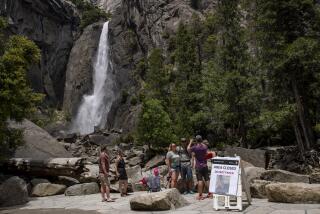Yosemite’s overcrowded -- with trees
YOSEMITE NATIONAL PARK — National parks tend to be a tree hugger’s paradise. Layers of federal laws, strict park service rules and even the disapproving scowls from some visitors prohibit so much as driving a nail into a tree, much less cutting one down.
But it’s getting a bit crowded in Yosemite, where more than a hundred years of prompt firefighting have allowed towering pines and cedars to clog the park’s meadows and valleys. These days, you can barely see the granite for the trees.
That’s about to change. Yosemite National Park officials say thousands of trees will be felled to preserve the iconic views of the park’s waterfalls and the craggy faces of El Capitan and Half Dome.
The project is part of Yosemite’s Scenic Vista Management Plan, approved by the park service’s regional office this week.
Chain saws will be fired up in the fall, said Supt. Don Neubacher, aimed mainly at ponderosa pines and incense cedars. Rare or ecologically sensitive trees such as California black oaks, sugar pines and white bark pines will be spared. None of the thousand-year-old sequoias will be cut, nor will any tree over 130 years old.
In public meetings and in person, park officials and rangers have been making the case that their tree-cutting plan is biologically sound and aims to improve visitor enjoyment of the park’s natural features.
To that end, much of the thinning will be done along the park’s roads and turnouts, where carloads of tourists pile out to snap pictures of Bridalveil or Yosemite falls.
Still, the public has let park officials know that there is something unseemly about the image of lumberjacks hewing mighty trees in the country’s oldest national park.
Neubacher understands visitors’ concerns about cutting trees in Yosemite, but says “this will create views for visitors, views that were here before.”
Yosemite was set aside as a national park in part because of the magnificent, wall-to-wall vistas afforded by its open meadows. Painters and early landscape photographers captured what are now emblematic images of the West: broad valleys rimmed by granite cliffs with spilling waterfalls.
Those open valley floors were maintained first by Native Americans who regularly set fires to clear trees, or by blazes sparked by lightning. Travelers in the 19th century grazed their livestock in the Yosemite Valley and planted crops, relegating trees to the edges of the meadows.
When landscape architect Frederick Law Olmsted prepared a report on the Yosemite region in 1865, he singled out the deep-cleft valleys for particular praise, calling the sight “the greatest glory of nature.”
But the park service moves quickly to stamp out fires that might otherwise thin the stands of trees that spread their seedlings into meadows. Some of those saplings are now towering to 100 feet, spoiling the party for tourists seeking to immortalize their vacation with a postcard backdrop.
Officials here have been thinking about the sightline issue for some time. In 2009, the park analyzed 181 scenic views around Yosemite, excluding wilderness areas. The survey revealed that encroaching vegetation obscured the view at 28% of the sites and partially blocked it at 54% of them.
“We are managing the park for people,” said Kevin McCardle, a park service historical architect who headed up the scenic vista team. “We have to create roads, we have to create parking lots, we have to create space for people. We are creating space for visitors to see the park.”
Visitors on a recent day seemed mostly unaware of the park’s plans to fell trees near meadows, roads and along some lakes -- 93 sites in all. Gary Lockhart was striding briskly along a Yosemite Valley trail, carrying a tree limb as a walking stick. He said he hadn’t heard of the new policy, but thought it was a good idea.
“I’ve been coming here since the ‘50s and I know what this used to look like. You used to be able to see from there,” he said, waving his stick to one end of the valley, “to there.”
“This valley was wide open,” said Lockhart, who lives in Bakersfield. “This place is honeycombed with trails, but you’d never know because of the trees.”
Of course, Half Dome, at 8,800 feet, is difficult to miss. But stands of pines gather at one end of a meadow along the Merced River, and at the far end trees clog the view of Yosemite Falls. And in some cases, a full view other well-known scenes may elude amateur photographers, especially as fast-growing conifers continue to fill in.
John Rienzie was resting on log bench, gazing across two lanes of a Yosemite summer traffic jam, enjoying the sight of the late-afternoon sun lingering on the crest of Half Dome. He pondered the policy for some time before saying he would agree “if there is a purpose to it.”
After a moment, the New Yorker asked again why it was necessary. To improve the views, he was told.
He looked up quizzically, “If you can’t see that mountain, “ he said, stabbing a finger at the distant granite wall, “you need to have your glasses checked.”
--
More to Read
Sign up for The Wild
We’ll help you find the best places to hike, bike and run, as well as the perfect silent spots for meditation and yoga.
You may occasionally receive promotional content from the Los Angeles Times.







